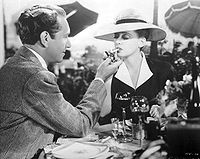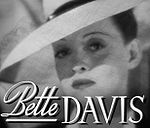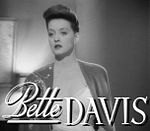- Now, Voyager
-
- For the album by The Cape Race, see Now, Voyager (album).
Now, Voyager 
Original posterDirected by Irving Rapper Produced by Hal B. Wallis Written by Casey Robinson Based on Now, Voyager by
Olive Higgins ProutyStarring Bette Davis
Paul Henreid
Claude Rains
Gladys CooperMusic by Max Steiner Cinematography Sol Polito Editing by Warren Low Distributed by Warner Bros. Release date(s) October 22, 1942 Running time 117 minutes Country United States Language English Now, Voyager is a 1942 American drama film starring Bette Davis, Paul Henreid, and Claude Rains, and directed by Irving Rapper. The screenplay by Casey Robinson is based on the 1941 novel of the same name by Olive Higgins Prouty.
Prouty borrowed her title from the Walt Whitman poem "The Untold Want," which reads in its entirety,
- "The untold want by life and land ne'er granted,
- Now voyager sail thou forth to seek and find."
In 2007, Now, Voyager was selected for preservation in the United States National Film Registry by the Library of Congress as being "culturally, historically, or aesthetically significant."[1] The film ranks #23 on AFI's 100 Years... 100 Passions, a list of the top love stories in American cinema. Film critic Steven Jay Schneider suggests the film continues to be popular due not only to its star power but also the "emotional crescendos" engendered in the storyline.[2]
Contents
Plot
Charlotte Vale (Bette Davis) is an unattractive, overweight, repressed spinster whose life is dominated by her dictatorial mother (Gladys Cooper), an aristocratic Boston dowager whose verbal and emotional abuse of her daughter has contributed to the woman's complete lack of self-confidence. Fearing Charlotte is on the verge of a nervous breakdown, her sister-in-law Lisa (Ilka Chase) introduces her to psychiatrist Dr. Jaquith (Claude Rains), who recommends she spend time in his sanatorium.
Away from her mother's control, Charlotte blossoms. The transformed woman, at Lisa's urging, opts to take a lengthy cruise rather than immediately return home. On board ship, she meets a married man, Jeremiah Duvaux Durrance (Paul Henreid), who is traveling with his friends Deb (Lee Patrick) and Frank McIntyre (James Rennie). It is from them that Charlotte learns of Jerry's devotion to his young daughter, Christine ("Tina"), and how it keeps him from divorcing his wife, a manipulative, jealous woman who keeps Jerry from engaging in his chosen career of architecture, despite the fulfillment he gets from it.
Charlotte and Jerry become friendly, and in Rio de Janeiro the two are stranded on Sugarloaf Mountain when their car crashes. They miss the ship and spend five days together before Charlotte flies to Buenos Aires to rejoin the cruise. Although they have fallen in love, they decide it would be best not to see each other again.
When she arrives home, Charlotte's family is stunned by the dramatic changes in her appearance and demeanor. Her mother is determined to regain control over her daughter, but Charlotte is resolved to remain independent. The memory of Jerry's love and devotion help to give her the strength she needs to remain resolute.
Charlotte becomes engaged to wealthy, well-connected widower Elliot Livingston (John Loder), but after a chance meeting with Jerry, she breaks off the engagement, about which she quarrels with her mother. Her mother becomes so angry that she has a heart attack and dies. Guilty and distraught, Charlotte returns to the sanatorium.
When she arrives, she is immediately diverted from her own problems when she meets lonely, unhappy Tina, who greatly reminds her of herself; both were unwanted and unloved by their mothers. She is shaken out of her depression and instead becomes interested in Tina's welfare. With Dr. Jaquith's permission she takes the girl under her wing. When she improves, Charlotte takes her home to Boston.
Jerry and Dr. Jaquith visit the Vale home, where Jerry is delighted to see the changes in his daughter. While he initially pities Charlotte, believing her to be settling in her life, he's taken aback by her acid contempt for his initial condescension. Dr. Jaquith has agreed to allow Charlotte to keep Tina there with the understanding that her relationship with Jerry will remain platonic. She tells Jerry that she sees Tina as his gift to her and her way of being close to him. When Jerry asks her if she's happy, Charlotte finds much to value in her life and if it isn't everything she would want, tells him, "Oh, Jerry, don't let's ask for the moon. We have the stars," a line ranked #46 in the American Film Institute's list of the top 100 movie quotes in American cinema.
Production
Producer Hal B. Wallis made Now, Voyager his first independent production at Warner Bros. under a new arrangement with the studio. He took an active role in the production, including casting decisions.[3] The initial choices for Charlotte were Irene Dunne, Norma Shearer, and Ginger Rogers.[4] When Bette Davis learned about the project, she campaigned for and successfully won the role. More than any other of her previous films, Davis became absorbed in the role, not only reading the original novel but becoming involved in details such as choosing her wardrobe personally. Consulting with designer Orry-Kelly, she suggested a drab outfit, including an ugly foulard dress for Charlotte initially, to contrast with the stylish, "timeless" creations that mark her later appearance on the cruise ship.[4]
The choice of Davis's leading men became important as well. Davis was aghast at the initial costume and makeup tests of Austrian actor Paul Henreid; she thought the "slicked back" gigolo-like appearance [5] made him look "just like Valentino." Henreid was similarly uncomfortable with the brilliantine image and when Davis insisted on another screen test with a more natural hairstyle, he was finally accepted as the choice for her screen lover.[6] In her 1987 memoir, This 'N That, Davis revealed that co-star Claude Rains (with whom she also shared the screen in Juarez, Mr. Skeffington, and Deception) was her favorite co-star.[7]
Initial production of the Prouty novel had to take into account that European locales would not be possible in the midst of World War II, despite the novelist's insistence on using Italy as the main setting. Prouty's quirky demands for vibrant colors and flashbacks shot in black and white with subtitles were similarly disregarded.[4] Principal photography was shifted to Warner's sound stage 18 and various locations around California including the San Bernardino National Forest, while European scenes were replaced by stock footage of Brazil.[6] One of the primary reasons for Davis being interested in the original project was that photography would also take place in her hometown of Boston.[4]
The film highlighted Davis's ability to shape her future artistic ventures, as not only did she have a significant role in influencing the decisions over her co-stars, the choice of director was predicated on a need to have a compliant individual at the helm.[3] Davis previously had worked with Irving Rapper on films where he served as a dialogue director, but his gratitude for her support turned into a grudging realization that Davis could control the film.[3] Although his approach was conciliatory, the to-and-fro with Davis slowed production and "he would go home evenings angry and exhausted".[6] The dailies, however showed a "surprisingly effective" Davis at the top of her form.[4]
For years, Davis and co-star Paul Henreid claimed the moment in which Jerry puts two cigarettes in his mouth, lights both, then passes one to Charlotte, was developed by them during rehearsals, inspired by a habit Henreid shared with his wife, but drafts of Casey Robinson's script on file at the University of Southern California indicate it was included by the screenwriter in his original script.[8] The scene remained an indelible trademark that Davis later would exploit as "hers".[9]
Cast
- Bette Davis as Charlotte Vale
- Paul Henreid as Jeremiah Duvaux Durrance
- Claude Rains as Dr. Jaquith
- Gladys Cooper as Mrs. Windle Vale
- Ilka Chase as Lisa Vale
- Bonita Granville as June Vale
- John Loder as Elliot Livingston
- Lee Patrick as Deb McIntyre
- James Rennie as Frank McIntyre
- Mary Wickes as Nurse Dora Pickford
- Janis Wilson as Christine "Tina" Durrance (uncredited)
Critical reception
Theodore Strauss, a critic for the New York Times observed that "Casey Robinson has created a deliberate and workmanlike script which more than once reaches into troubled emotions. Director Irving Rapper has screened it with frequent effectiveness. But either because of the Hays office or its own spurious logic, [the film] endlessly complicates an essentially simple theme. For all its emotional hair-splitting, it fails to resolve its problems as truthfully as it pretends. In fact, a little more truth would have made the film a good deal shorter ... Although Now, Voyager starts out bravely, it ends exactly where it started — and after two lachrymose hours."[10]
Awards and nominations
- Academy Award for Best Actress (Bette Davis, nominee)
- Academy Award for Best Supporting Actress (Gladys Cooper, nominee)
- Academy Award for Best Original Score (Max Steiner, winner)
References
- ^ "National Film Registry". Library of Congress, accessed October 28, 2011.
- ^ Schneider, p. 183
- ^ a b c Leaming, pp. 204-205
- ^ a b c d e Higham, pp. 159-167
- ^ Quirk, p. 248
- ^ a b c Spada, pp. 189-190
- ^ Davis and Herskowitz, p. 26
- ^ Now, Voyager at Turner Classic Movies
- ^ Moseley, p. 70
- ^ New York Times review
Bibliography
- Davis, Bette, with Herskowitz, Michael, This 'N That. New York: G.P Putnam's Sons 1987. ISBN 0-399-13246-5
- Leaming, Barbara, Bette Davis: A Biography. New York: Simon & Schuster 1992. ISBN 0-671-70955-0
- Higham, Charles, Bette: The Life of Bette Davis. New York: Dell Publishing 1981. ISBN 0-440-10662-1
- Moseley, Roy, Bette Davis: An Intimate Memoir. New York: Donald I. Fine 1990. ISBN 1-55611-218-1
- Quirk, Lawrence J., Fasten Your Seat Belts: The Passionate Life of Bette Davis. New York: William Morrow and Company 1990. ISBN 0-688-08427-3
- Schneider, Steven Jay, 1001 Movies You Must See Before You Die. Hauppauge, New York: Barron's Educational Series 2005. ISBN 0-76415-907-0
- Spada, James, More Than a Woman: An Intimate Biography of Bette Davis. New York: Bantam Books 1993. ISBN 0-553-09512-9
External links
- Now, Voyager at the Internet Movie Database
- Extensive summary and commentary at Filmsite.org
- Commentary at the University of Alberta website
- Discussion of the novel and the movie
- Download the 1943 Lux Radio Theater version of this film
Films directed by Irving Rapper 1940s Shining Victory (1941) · One Foot in Heaven (1941) · The Gay Sisters (1942) · Now, Voyager (1942) · The Adventures of Mark Twain (1944) · The Corn is Green (1945) · Rhapsody in Blue (1945) · Deception (1946) · The Voice of the Turtle (1947) · Anna Lucasta (1949)1950s The Glass Menagerie (1950) · Another Man's Poison (1951) · Forever Female (1953) · Bad for Each Other (1953) · Strange Intruder (1956) · The Brave One (1956) · Marjorie Morningstar (1958) · The Miracle (1959)1960s Pontius Pilate (1962) · The Story of Joseph and His Brethren (1962)1970s The Christine Jorgensen Story (1970) · Born Again (1978)Categories:- 1942 films
- American films
- English-language films
- 1940s drama films
- American drama films
- Black-and-white films
- Films about psychiatry
- Films based on novels
- Films directed by Irving Rapper
- Films set in Massachusetts
- Films set in Rio de Janeiro
- United States National Film Registry films
- Warner Bros. films
- Best Original Music Score Academy Award winners
Wikimedia Foundation. 2010.






